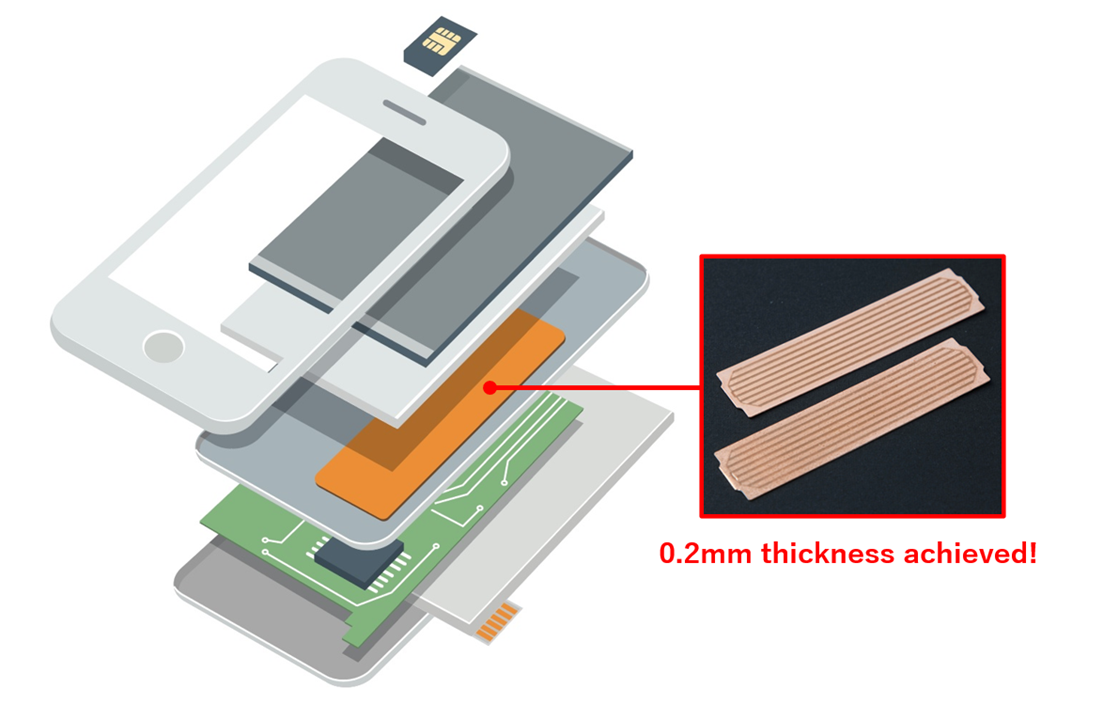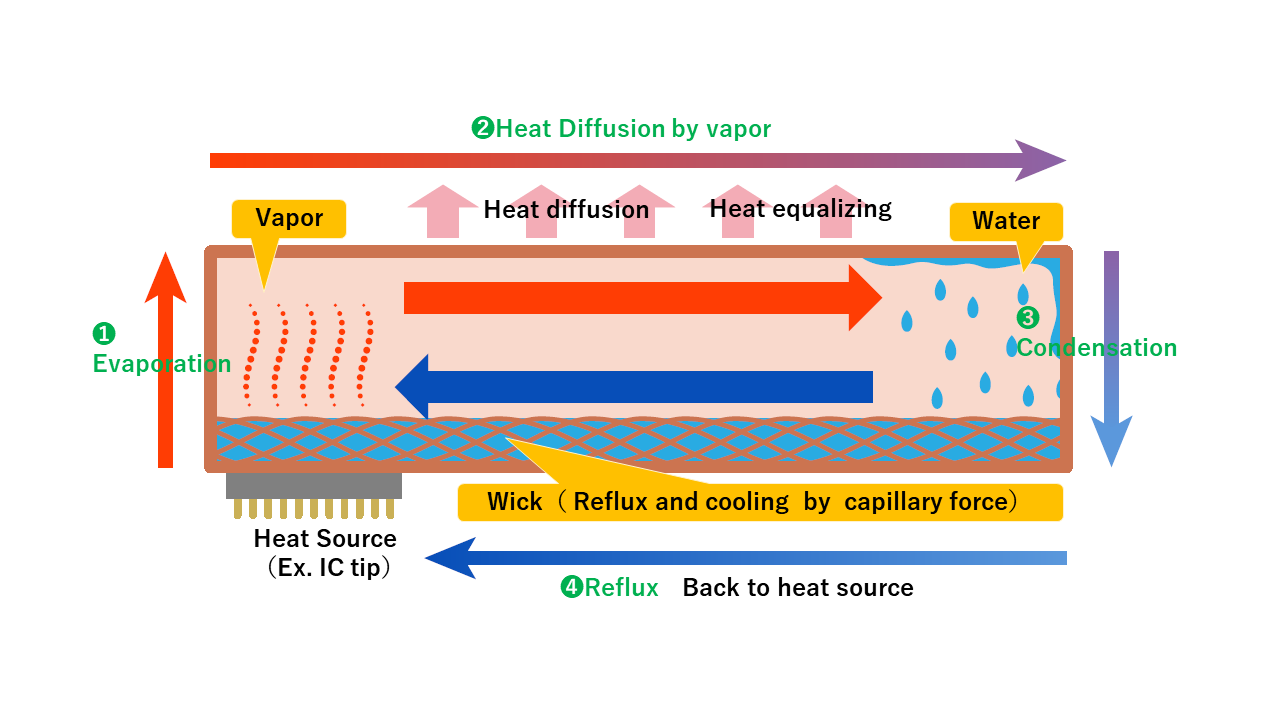Advanced Thermal Management and Miniaturization Solutions for 5G-Ready Devices
Vapor Chamber
Vapor Chambers are a type of "metal heat-dissipating component" similar to heat pipes, with the ability to instantly transfer heat by the vaporization and condensation of liquids. Compared to commonly used graphite sheets in thin devices, Vapor Chambers offer superior thermal conductivity, enabling rapid heat diffusion and dissipation. As 5G compatible devices are anticipated to become more widespread, there is a need for heat dissipation solutions for electronics such as application processors and integrated circuits used for communication due to the increase in the data processing of those high-capacity, and high-speed communications. Vapor Chambers are expected to play an active role as a solution for the heat management of miniaturized electronic devices for which thinner, high-performance, power-saving thermal components are required. DNP has achieved the development of a thin Vapor Chamber that incorporates high thermal conductivity, and the flexibility to be applied to uniquely shaped spaces.
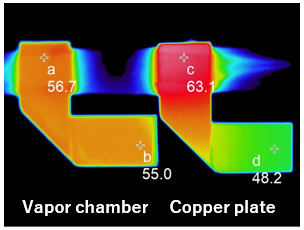
See 11 related fields
- Working principle of a Vapor Chamber (Cooling system)
- How it differs from other heat dissipating components
- Special features of DNP's Vapor Chamber
- Anticipated future applications
- Click here for price estimates or technical consultation
|
|
Working principle of a Vapor Chamber (Cooling system)
The Mechanism
Commonly, a Vapor Chamber works to lower the temperature of the device it serves via a repetitive transfer process.
For example, an Integrated Circuit (IC) generates intense heat. The Vapor chamber is separate to the IC, but they’re connected via thermal grease, glue, or TIM. Heat is able to flow through this connection into the Vapor Chamber. When the heat from the IC hits the working liquid stored inside the wick, it transforms the water into vapor which inhabits the chamber.
The heat is then defused, and the condensation formed by the evaporation solidifies back into a cooler fluid. This then moves through the connection, back to the IC. This occurs in an endless loop, continuously drawing excess heat from the IC to offset overheating.
|
|
①The working fluid which is sealed inside (pure water) evaporates when heated.
②The evaporated working fluid (vapor) flows through the chamber, and the heat is diffused.
③The diffused vapor is cooled and becomes liquid again (condensation).
④The liquified working fluid is returned to the heat source through capillary action.
(Steps 1 - 4 are repeated continuously)
The Vapor Chamber is a hollow structure comprised of flat metal plates affixed together, with a capillary tube called a "wick" spanning across, and a working liquid such as pure water sealed inside. It lowers the device's temperature through a cyclical process: the working fluid evaporates, spreads heat inside the chamber, and condenses back to liquid form, repeating continuously.
Vapor Chamber Components
A typical Vapor Chamber comprises three components. Firstly there are the plates which are constructed from metal and fixed together to form the top and the base, leaving a hollow space between them.
The second component is the wick, which lines the space formed by the plates, spanning the entire length. This could also be referred to as the capillary tube — the wick is soaked with water. The third component is the connection between the Vapor Chamber and the heat source, which is generally heat transfer grease, glue, or TIM.
These components form a home for the working liquid (generally pure water) which is key to the heat diffusion which occurs inside a Vapor Chamber.
Vapor Chamber Applications
Mobile, Head Mounted & Sensing Devices
The constant insistence towards miniaturization inherent to the electronics industry demands that thermal management technology evolves alongside.
Consumer electronics like mobile devices and head-mounted displays for virtual, augmented and mixed-reality users require chip-cooling solutions that can accommodate high-level heat flux. This is also true for applications across sensing devices, including light source units, cameras and other data-acquiring devices.
Elevated processing capacity utilizing Vapor Chamber technology is increasingly vital as 5g compatible devices take hold of the market share. As data loads have increased, heat dissipation must become more efficient, and installations become more dynamic in terms of the increasingly smaller spaces they are required to inhabit.
Vapor Chambers serve high-level heat dissipation, operating in spaces where traditional heat pipes simply won’t fit. For wearable devices, this allows increased miniaturization and more elite design that leans into comfort and user-friendly features that no longer need to work around clunky heat dissipation components.
Electronics that utilize Vapor Chamber tech may be non-linear, exceptionally narrow, and can flexibly conform to myriad shapes — so user comfort needn’t be compromised to accommodate essential heat dissipation.
Laptop Applications
The global movement towards remote working arrangements is on the rise, and digital nomads demand better, faster and smaller ways to connect or disconnect outside of traditional power source environments.
Vapor Chamber technology is proving to be an essential tool to address the move away from the desktop to the laptop. Thermal conduction and heat transfer in laptops happen due to componentry contacting the substrate or thermal conduction through the wiring or board. It also occurs as heat is transferred convectively from the surfaces to the air and is emitted as electromagnetic waves via radiation.
For laptops, Vapor Chambers are used in conjunction with traditional heat dissipation technologies such as graphite sheets or heat pipes and sinks to lend further rapidity to heat transference. Adding Vapor Chambers into the mix allows heat dissipation across a larger area at a faster rate.
For laptops, interior space is limited. Vapor Chambers can work efficiently within these confined spaces by transferring the heat to heat sinks strategically placed close to ventilation points — without the need for an external power source.
How it differs from other heat dissipating components
Heat Sink
Advantages:
Low cost and good heat dissipation.
Drawbacks:
Low thermal conductivity, heavy and voluminous (making it difficult to miniaturize or make thinner), and if the material is metal, there is a risk of a short-circuit due to its conductivity.
Heat Pipe
Advantages:
Extremely high thermal conductivity.
Drawbacks:
They require a certain degree of thickness due to their structure (making them difficult to make thinner), they lose efficiency if the heat source is located in a high position, and they are unable to diffuse heat over a wide area by themselves due to their round (pipe) shape.
Graphite Sheet
Advantages:
Lightweight, can be made extremely thin, flexible, and they function as an electromagnetic shield.
Drawbacks:
Low thermal conductivity compared to heat pipes and Vapor Chambers, the amount of heat they can carry is low, and they are conductive, so there is a risk that fine powder like substances from the sheets can affect electronic circuits.
Vapor Chamber
Advantages:
Extremely high thermal conductivity, the amount of heat they can carry (heat transportability) is very large, and they can be made to be thin. Even when the heat source is located in a high position, they do not lose efficiency (compared to heat pipes). Due to their flat shape, they can instantly spread heat over a wide area.
Drawbacks:
Higher cost relative to other heat dissipating components.
Special features of DNP's Vapor Chamber
The "Thin Vapor Chamber" developed by DNP has a higher thermal conductivity than graphite sheets, has a thinner profile than heat pipes, and can be flexibly formed making it the optimal component for the thermal management of thin devices.
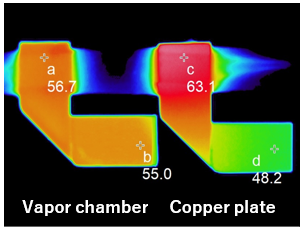
|
|---|
■Can be made especially thin
Achieved a thickness of 0.20mm.
■Flexibility
Can be applied to components with curved or graded surfaces.
■High heat resistance
Doesn't break even in environments up to 150℃.
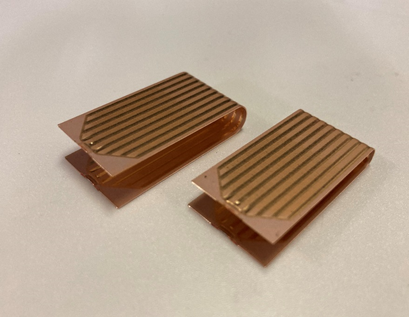
|
|---|
| DNP's flexible Vapor Chamber |
- More design freedom thanks to flexible heat dissipating material
By taking advantage of the special characteristics of DNP's Vapor Chamber, not only can it be applied to conventional mainstream thin devices, it can also be bent to accommodate devices with complex shapes.
In the case of smart glasses for example, in addition to the CPUs which do data processing, it is also necessary to implement thermal management in several other areas such as the displays, sensors, and batteries. Each of these are assumed to require heat dissipation components to be installed in extremely narrow and oddly shaped spaces, and it is considered very possible that DNP's Vapor Chamber will able to excel at this task.
Anticipated future applications

|
|---|
- Thermal management in oddly shaped spaces such as for wearable devices
In order for 5G compatible devices to handle large amounts of data, it is necessary to employ high-efficiency heat dissipation components. Additionally, it is expected that there will be many cases where the spaces in which the heat dissipating components need to be installed will be extremely narrow and non-linear, so the required heat dissipating components must be able to flexibly conform to different shapes depending on the parts of the body where they are worn.
DNP's Vapor Chamber, equipped with both high thermal conductivity and flexibility, is considered to be the ideal component for the heat management of wearable devices.

|
|---|
- Heat dissipation to achieve device miniaturization
There's no better path forward to reduce the size of existing products than to reduce the space used by heat dissipation components. DNP's Vapor Chamber can provide great heat dissipation using a minimum amount of space. Also, since it can be used without a power supply, the lack of a fan greatly contributes to device miniaturization and reducing power consumption.
For technical inquiries or consultation
Please use the inquiry form below for any technical inquiries regarding DNP's Vapor Chamber.
After reviewing your inquiry, we will discuss in detail and consider your specific requirements individually.
In order to facilitate a smoother evaluation process, we kindly request that you review the frequently asked questions (FAQs) beforehand and provide the following information:
・Intended application / expected operating environment of the product
・Number of heat sources / heat dissipation (W) / size (mm)
・Layout of internal components (position of heat sources, etc. within the enclosure)
・Production timeframe / estimated quantity (※MOQ 10Kpcs)
※Please provide the above information to help us better understand your requirements and proceed with the evaluation process more smoothly.
FAQs
| Q: What are the materials used in DNP's Vapor Chamber? | A: The materials used are pure copper, copper alloy, and stainless steel. |
| Q: What are the supported sizes of DNP's Vapor Chamber? | A: The Vapor Chamber has a thickness ranging from 0.20mm to 0.80mm, a width (X) ranging from 15mm to 80mm, and a length (Y) ranging from 70mm to 115mm. |
| Q: How should I use DNP's Vapor Chamber? | A: DNP's Vapor Chamber is a heat transport component. We recommend using it by connecting it between the heat source and the heat sink, such as a frame enclosure. |
| Q: Can I purchase a ready-made product? | A: We do not offer ready-made products. We specialize in providing custom-made products tailored to your specifications. |
| Q: How much does the product cost and what is the initial cost? | A: The price and initial cost vary depending on the specifications and quantity. Therefore, we will provide a personalized response after discussing and understanding your specific requirements. |
Related pages
DNP in Electronics

|
|---|
Other than listed above, DNP’s Electronics segment has a wide range of products for digital interface (display-related) and semiconductor.
You can check further our product line-up here and find anything to accommodate your needs.
DNP's Technologies for Next-Gen AR Glasses/VR Headset
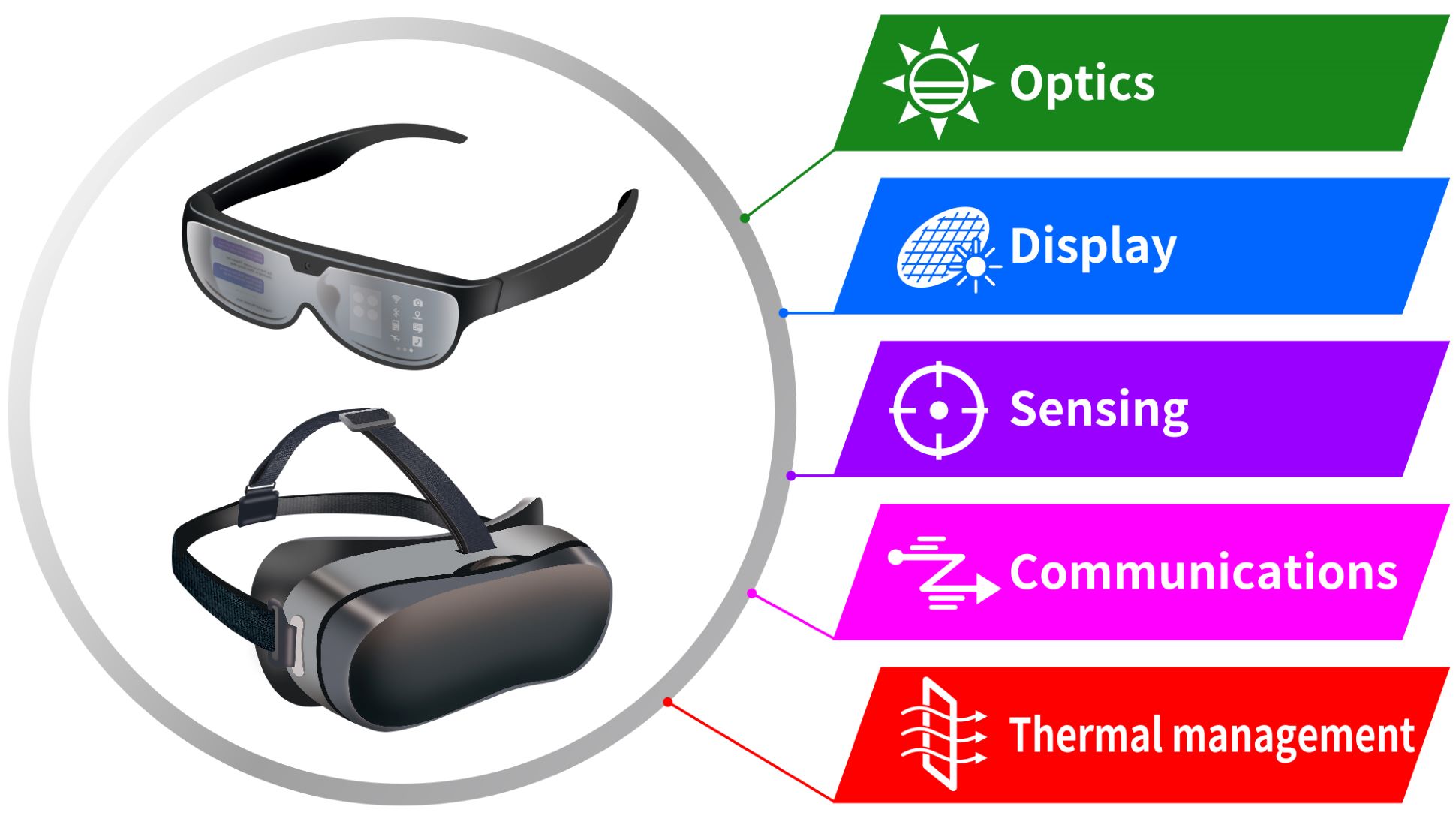
|
|---|
In particular, AR glass and VR headset related items are listed here and may provide you with some solutions. Please click below for more details.
See 11 related fields
